|
There has been much talk of a film dedicated thread and no one has done much about it I decided to take the plunge and get this party started. Scanning thread = http://forums.somethingawful.com/showthread.php?threadid=3307521 Scan processing video that gets asked for every 3 pages:https://www.youtube.com/watch?v=u_qeZOWqchM First of all, why film? Well I shoot film because I like it and because I was broke when I got into photography and couldn't afford a DSLR. The larger formats are still used professionally today because they can produce the quality needed for a fraction of the price of digital capture. Frankly alot of people shoot film because they always have and it works for them. Understandable, why fix what ain't broke. Edited: Why film in 2012? I still shoot film because I like it. I like the smoother highlight transitions and the increased dynamic range (not by much at this point). Somethings to consider about film in 2012: How broke are you? Shooting film is hideously expensive. I am all for people buying film gear and shooting film but seriously don't waste the money on a nice camera is you are only gonna shoot a couple of rolls and move back to digital. What system are you shooting now? You can probably find an old consumer 35mm body for it very cheap. Then once you have the infrastructure built up buy a good body or even better a medium format camera. What do I mean by infrastructure? We had an IRC discussion not long about the associated costs of being a film shooter. Film stock, development, scanning, scanning software that doesn't suck rear end, film holders that don't make you want to die, and negative storage. A scanner will pay for it's self after a few rolls and if you can't afford to buy one you can't afford to shoot film. What is film? Film is light sensitive dye clusters or silver halide crystals embedded in layers of gelatin. Dye clusters are used for color film and silver halide makes black and white images. Black and white film has one color sensitive layer, color film has three. One for red, blue and green respectively. Film Sizes: From smallest to largest. Quality increases and grain decreases as you use larger film. 35mm - also called 135, commonly available in rolls of 24 or 36 exposures. Comes in a metal cannister and has sprocket holes for cameras to wind it. Most commonly loaded on one side of camera and wound around a non removable spool in the camera body then rewound into the cylinder after all exposures made. 120 - Medium format, 2.5 inches wide and 28 inches long. Comes on a plastic spool and is tranfered to another spool on other side of camera. Film is sprocketless and backed with paper. There is a little adhesive tab on the paper to seal the film after exposure. 220 - same width twice the length of 120, not all medium format cameras can take this film size. Sheet film - available in many sizes. Very cool. Requires big heavy camera but provides the best quality.  The three common types of film processing: C-41: Most common. Negative color film. Images are captured on the film with the colors reversed, and printed so that they come out as a positive on paper. Uses clusters Can be processed at home but is complicated, most people have this done by a lab. The earliest negative processes were quite unstable and tended to fade. I believe any color film made since the early 80s is unlikely to fade. Requires weird color filtration system to print. E-6: Slide or reversal film. The image is developed as a positive directly on the film. Until the advent of digital photography this was the primary medium of professional photographers due to color fastness and longevity. The printing process is very different from C41 and produces very beautiful colorful prints. K-14: Kodachrome made famous by national geographic and a song by Paul Simon. Very colorful slides, noted for its signature reds and browns. There is only one lab in the world that still develops this film. Film basics: Loading the camera: Should be easy unless you have a Leica rangefinder, but if you have one of those I'm sure you know how to load it. ISO: You should all be familiar with this, the system of rating film speed. Most commonly ISO 100, 200, 400, 800, and 1600. The lower the ISO the smaller the grain and the less sensitive to light it is. ISO 100 film requires twice the exposure of ISO 200 to capture the same scene. Higher ISOs have more contrast (less shadow detail) Pushing/ Pulling: You can not change the ISO of a film. Flame me if you want but film is rated by the manufacturer and that it. You can, however, change the EI (exposure index) meaning under/overexpose the film and develop accordingly. We do this for many reasons, say you only have ISO 800 film and it's getting dark, underexpose the film by one stop nad have the lab develop the film for longer and you have just pushed to EI 1600. Conversely if you are trying to capture a scene with a very high dynamic range, you can underexpose and reduce the development for increased shadow detail. Remember this phrase: Expose for the shadows and print for the highlights. With negative film the longer you expose the film the more detail you have in your shadows. Thus by pulling the film you have given more exposure to your shadows and by cutting development (the standard is 20% of your time per stop pulled) you have reduced the highlights. Notes on slide film: Reversal film acts the opposite way that negative film does during exposure. It reacts like digital capture, overexposure will lose your highlights so be careful. Grain: A much debated topic. I love film grain, hell I like digital noise (as long as it isn't coarse noise that stuff sucks). The reason film grain increases with ISO is that much larger bits of light sensitive material are needed to capture light when there is less of it. Also the grainier an image is the more apparent sharpness it has. A shot that would look a bit soft at ISO 100 will probably look sharper at ISO 1600. Certain processes and developers can increase the grain and the sharpness of the grain. Storing film: Keep it cool and dry. Heat with age film and cause color shifts and increased grain. Some links: Here is an amazon list of basic equipment you need to develop black and white film. The only thing I omitted is the film. I prefer to buy all my stuff locally but seeing how this is the internet I figured you guys would be into this. http://www.amazon.com/Creative-Convention-s-New-Film-User-Equipment/lm/R2W2L5CU8VZEGA/ref=cm_lm_pdp_title_full A cool place to buy film and chemicals: http://www.freestylephoto.biz/ Keh is my favorite online gear depot, very trustworthy, lots of good equipment. http://www.keh.com/OnLineStore/BrandTableOfContent.aspx Some Flickr groups dedicated to film that I belong to: http://www.flickr.com/groups/film_is_not_dead/ http://www.flickr.com/groups/tri-x/ There are a ton more, just search for them. The home developers online bible: http://digitaltruth.com/devchart.html If you are into Tri-X check this out: http://www.covingtoninnovations.com/hc110/ No analog thread would be complete without a link to the Analog Users Group, these people know their stuff: http://www.apug.org/forums/home.php Up Next: I have photos and will walk you through how I develop my film. 8th-snype fucked around with this message at 04:40 on May 6, 2014 |
|
|
|

|
| # ¿ Apr 27, 2024 07:15 |
|
Yeah I don't know much about scanning and what not. I have my Lab do that. I figured that between all of us we have enough experts to answer basically anyones questions.
|
|
|
|
Well now seems like a good time to go over B&W film developing. I only use one B&W film, Tri-X, because it's so versatile. You can shoot it at an EI from 50 to 12,800 and get acceptable negatives. Sure they are a bit grainy and contrasty but I'm in that. I suggest you mess around and find one film you like then stick with it until you know everything about it. The same with developers. I use HC-110 for 2 reasons. One, it's a concentrated syrup which makes it easy to mix one shot working solutions. Two, when I got into developing my own stuff I was a huge Ansel Adams fanboy and that is what he used. Firstly list of everything you will need: http://www.amazon.com/Creative-Convention-s-New-Film-User-Equipment/lm/R2W2L5CU8VZEGA/ref=cm_lm_pdp_title_full Feel free to omit the Ansel Adam's book if you want it's not really a beginners kind of text. Chemicals: You are goons so go find some empty mountain dew bottles. One and two liters and a few 20oz bottles. These are for storage. Developer: Actually makes the photo a photo by turning silver halide crystals into metallic silver depending upon whither or not they were exposed to light. There are much more knowledgeable people out there about differences in the many differnt types of developers. 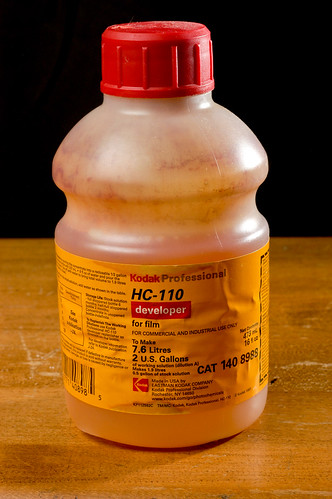 Lets assume you have a roll of Tri-X shot at 400 you want to develop in HC-110. Since we are not going to get all crazy the first time out of the box we will use the standard dilution "B". Dilution 'B' Recipe: 9.4 ml of HC-110 300 ml of water. Why do I use 300ml at a time? Because the patterson tank requires 290ml of fluid to cover one roll of 35mm. So I'm always making up just enough to develop one (or by doubling it) two rolls of film.  stop bath: To stop the developers action when the appropriate time has arrived. Not needed use water. Fixer: This washes out the silver halide crystal that have not been exposed to light. Making the image light proof and permanent.  I use Kodafix. I make up a liter at a time. You dilute Kodafix 1:3 with water so a liter would be 250ml of fix and 750ml of water. Permawash: Just helps to wash out the fixer. 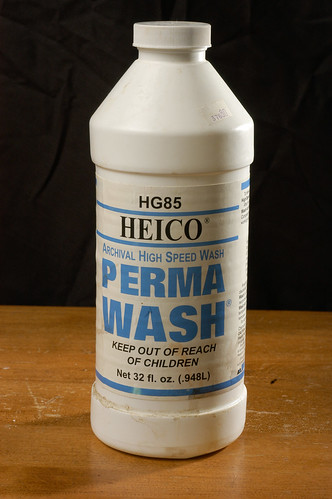 I do all my measuring with a graduated cylinder for the larger amounts:  I use needless syringes for the smaller amounts, 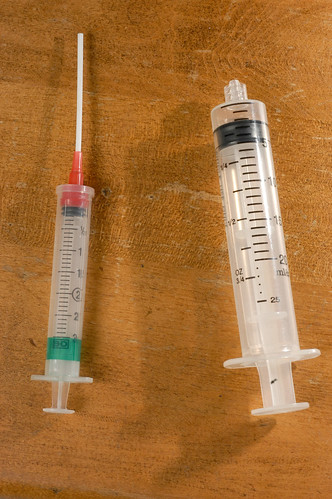 but you could use smaller graduated cylinders. So now that you have mixed your chemicals go get your film. You need a pair of scissors, a dark room, a can opener and the patterson tank system for this next step.  First make sure the room you are in is completely dark. Then spread out the tank so that you know where all the pieces are in the dark (hosed that one up a few times). Now you use a can opener to pry the top of the film cannister off. This allows you access to the film and spool. Take that right out of the container. Snip off the film leader so that the whole film has the same width. Save the leader we are going to need that later. Now take the film in one hand and the auto loading reel in the other. Carefully feed the film into the opening on the reel. Once there is a few inches in you can start ratcheting the reel (it was designed to do this, hence the auto loading name). After a few minutes the film spool should be very close to the reel, take your scissors and snip the tape holding the spool on and ratchet until the film is all up in there. Now you want to take the hollow piece of the tank 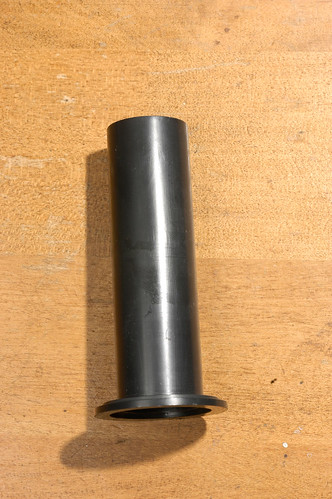 and slide the reel onto it  now place them in the tank 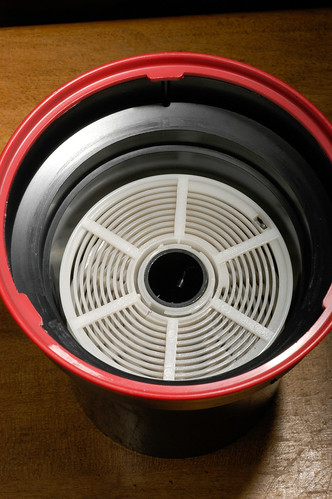 and place the funnel looking thing over them, being sure to twist and lock it in place. 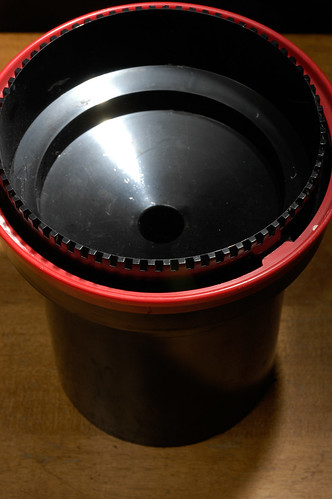 Now you are ready to pour in chemicals. The system is light tight at this point so feel free to come out of the closet (or where ever). Make sure your solutions are all about 20 degrees centigrade. 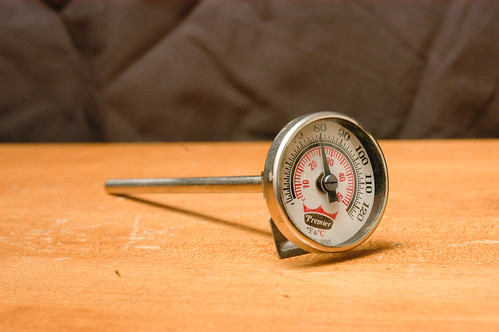 Set a timer and pour in your developer. It needs to be in there for 7 minutes with this film/developer combo. Use this http://digitaltruth.com/devchart.html to get all the times you need, it's not perfect but it gets you in the ball park. Agitation: moving the tank during development to move fresh developer onto the film and to reduce air bubbles. I use 30 seconds of initial agitation by gently rolling the tank on a counter and tapping the base to remove air bubbles. Then I agitate 5 slow inversions every 5 minutes. Most people think I'm crazy but this works for me. It allows the developer more time to develop the shadows and does not replace the burnt out developer in the highlights as often. For really big pushes I agitate even less. After seven minutes pour out the developer and fill the tank with water. This will stop the developers action. Acid stop bath will stop it faster but I have found you get just a smidge of further development in the shadow areas if you use water as it takes time for the water to soak into the film. Now is good time to do a clip test for your fixer. We do this because it's easy and we reuse fix so this will tell use when it is getting older and weaker. Take that film leadre we talked about saving and run some water over it. Then throw it in a shot glass. 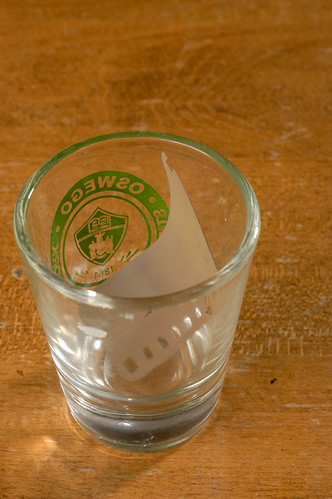 Splash in a enough fixer to cover the bottom half of the film. Time how long it takes for the film to become clear (usually around three minutes) double that and you have the time you are going to use to fix the film in the tank. Now pour out water and in goes the fix. Agitate for 30 seconds continuously then 10 seconds every minute. Pour in some permawash solution and let it sit for a few minutes. Now fill up the tank with fresh water and invert it ten times, empty and fill it again inverting 20 times, repeat with 30 inversions. The film si now washed and ready to come out of the tank. Some people use photo-flo (liquid soap) as a final step, I only recommend this if you have hard water. Here is where you will need these. 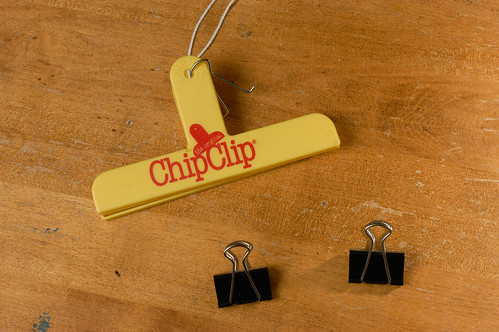 There is no reason to spend a ton of money on film hangers when the grocery store has what you need for 99 cents. Carefully remove the film from the reel. While the emulsion is still wet it is very fragile and can be scratched easily so be careful. Clip one end on the chip clip:  and the other clip a binder clip to 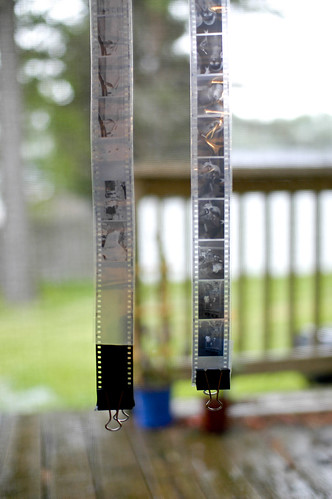 Now hang you film in a dust free area nad wait a few hours for them to dry. 8th-snype fucked around with this message at 10:17 on Jul 16, 2008 |
|
|
|
Luxmore posted:Yup, excellent post. Fix gets weaker as it gets older. Hypo test will tell you when to throw it out but not how much longer to leave your film in the fix later on in it's life span. I try not to throw out fix until I have to as it is the only item in my workflow that is considered hazardous waste. That and I don't have to buy hypo check if I don't use it. The cardboard box I store my chemicals in is already overflowing.
|
|
|
|
I want a large format camera, bad. I need to upgrade my DSLRs first.
|
|
|
|
hybr1d posted:I can't for the life of me remember where I bought my Yashica TLR. It was used, and not from B&H or Adorama. Where do you guys recommend looking for used gear? If I'm lucky I can find the same retailer again. Keh.com. I am an untrusting bastard and these people impress me.
|
|
|
|
Krispy Kareem posted:Looking at my shopping list, I think I'm just going to get the new container. In my youth I'd be all over spare parts, but I'm not sure what kind of luck I'm going to have finding a cover and if it's online there will be shipping charges at least equal to the item cost. Plus I need $50 in stuff for Adorama to ship free and I'm only at $44 even with the developing tank. Thanks for the offer though. What developers are you looking at? Most stuff comes in a concentrate form.
|
|
|
|
More example photos: Tri-X pulled to EI 200.  Tri-X shot at 400 (I should have pulled at least one stop but I was stupid) 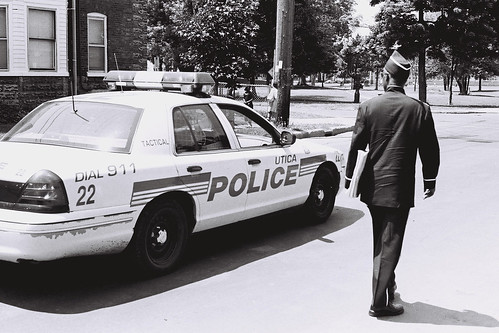 Tri-X at EI 3200 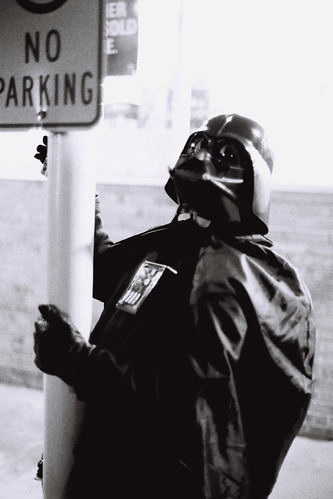 And I know how much we all hate pet photos but these are the only examples of I have of a lower ISO. These were both shot with T-Max 100 I think I pulled it to EI 80. 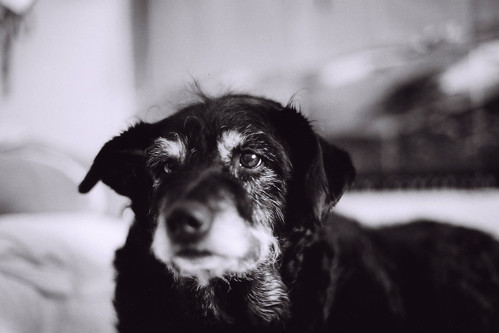 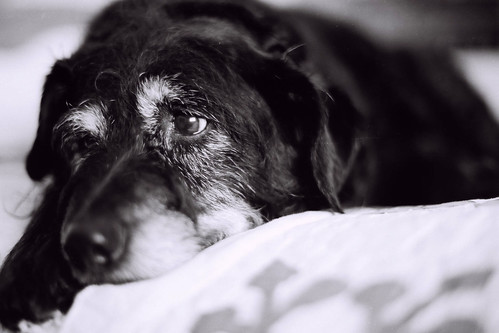
|
|
|
|
What type of reel/tank? Like the man said, looks like the chemicals didn't get to parts of the film, possibly because it was stuck to it's self.
|
|
|
|
gib posted:I just shot a roll of Portra 400 NC at a wedding. Where should I get it developed and printed, and does the chemistry used (Kodak vs. Fuji) matter? Avoid any place that will one hour your film. The Kodak portra line is a pro film stock and can be damaged by the one process. find a decent pro lab or send it out. Trust me on this one I used to shoot alot of Portra UC before they discontinued it and I had a few mishaps when I was in a hurry to get my negs. 8th-snype fucked around with this message at 23:23 on Jun 9, 2008 |
|
|
|
I can't find any documentation to back me up. Maybe things have changed since the last time I shot Portra. Kodak used to recommend not going to a one hour photofinisher in the tech pubs for their pro films. I have never had good luck with drugstore prints or developing. I have had scratched negatives and prints with crooked borders (not to mention bad color correction).
|
|
|
|
I'm thinking of getting some Efke 25 in 120. To shoot long exposures on my Yashica 635 in daylight. I saw these amazing photos some russian guy took in St Petersburg of crowds moving through the city. All ghostly body parts and sharp buildings. I want to do something like that in my city. Anyone ever use this stuff? I know they recommend a hardening fixer, which Kodafix is so Im good, but any other personal tips would be nice.
|
|
|
|
I love my yashica. Seeing that picture makes me want to go out and finish the roll of film in my 635. Except for that I think its ektachrome and the light sucks around here right now.
|
|
|
|
Well Im an idiot. I have been patching up the leather case for my Yashica 635 and taking the drat thing off to change film. I saw the strap on that 124 and immediately put a spare one I had lying around on it. Much better this way.
|
|
|
|
I used to shoot a bunch of Kodak HIE. The film can act as a light pipe and fog inside the cannister, I heard it was due to a lack of antihalation layer. However unless you expose the cannister to really bright light on the side the film comes out the most you will ever see is a bit of fog on the end of your leader. I have never had an image fogged and I have changed film at noon using my body to shade the camera. However I have no idea what long term exposure of medium light levels will do to it, I just wanted to let everyone know that its not as bad as made out to be when light gets to your IR film.
|
|
|
|
killabyte posted:I need some ideas or anyone with experience on develping ancient film. Diafine. It will reduce the fog on the film, I have seen 70 year old negs come out printable with that stuff.
|
|
|
|
Clayton Bigsby posted:Diafine will also solve world hunger, give you a back rub, make coffee and walk your dog. Or drat near. And all the cool kids are using it.
|
|
|
|
killabyte posted:An update: They look overexposed? Or are they really light? Hardening fixers just make washing the film take longer there shouldn't be any other difference in modern films.
|
|
|
|
hybr1d posted:My Pentax K1000 isn't moving the film correctly from the cannister to the right hand reel. I had first assumed I had just not seated the roll correctly and the film was just slipping- then I ran a roll in the daylight and found the spindle with the teeth 'slips' and as such doesn't always pull the film forward all the way to the next frame. I suspect one of the gears has missing or worn teeth, and it only slips when I get to that side of the gear. Buy another one, K1000s are not collectible. Keh.com has plenty of manual K-mount camera.
|
|
|
|
Reichstag posted:Well, looks like the only pictures that DID come out were the ones I used flash on. I don't know what the gently caress is up with this camera, but here is an example of the poo poo it pulled over the fourth: Looks like a light leak.
|
|
|
|
Shadow detail is for wimps and communists. 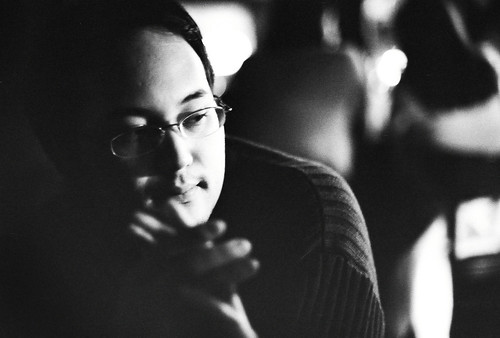
|
|
|
|
Right. His point is that diafine naturally controls conrast, if fact it sucks at developing negs shot in flat light. If you overexpose and or develop you get high contrast, which through magical diafiney goodness ends up looking good.
|
|
|
|
Overdeveloped means just that. Left in the developer too long. Tends to cause highlights to block up. Remember that generally when you over develop film you are compensating for underexposure but exposure and development are 2 completely separate variables. Meaning the long you expose negative film the more shadow detail develops. Conversely as you gain shadow detail you lose highlight detail. This assumes that the scene contrast exceeds the 11 stops that B&W negative film can record. As a rule anything 7 stops brighter than your deepest shadow that retains detail is going to pretty much wash out. We can combat this in several ways. Remember this phrase (there will be a test) "expose for the shadows and develop for the highlights". 1: You set your exposure roughly 3 stops brighter than the darkest area that you want to retain detail in. Then you can cut development by a stop or two to get an area that is just out of the films contrast "reach" to retain some detail. This really only works if you spend alot of time comparing the highlight and shadow areas in the scenes you are shooting and have done extensive film/developer testing. 2: Expose your high contrast scene at what ever EI you feel like and develop accordingly. Just make sure you are using a developer like HC-110 that can be diluted to practically any strength you want. Make up a half strength batch (dilution H with HC-110) and double the time you leave the film in there. Then drastically cut down on the agitation. I agitate like between 3 and 5 inversion every 5 minutes. You see developer exhausts faster in the highlights than the shadows because there is less silver in the highlights. So when you agitate you are replacing that exhausted developer with fresh stuff. Let it sit and the shadow areas keep developing while the deveopment of the highlights is retarded. 3: Two bath developers like our friend Mr Diafine. These reduce contrast intrinsically because of the way they work. The first bath is the developer and the second is the catalyst that activates the developer. The amount of developer available to convert silver halide into silver is only what is soaked up by the film in the first bath. Once the developer in the highlights is exhausted thats it its gone. This explains the Diafine magic pretty well: http://www.dunnamphoto.com/diafine_developer.htm 8th-snype fucked around with this message at 09:56 on Jul 14, 2008 |
|
|
|
porcellus posted:Wait I'm confused. I'm developing my first ever two reels today, and your HC1110 solution is 1:63, the solution I'm using. Isn't B Solution 1:31? Apparently 1:62 is called H solution, doubling the time of using B, but you're using the time for B. So is the Dev chart actually listing H solution (it says B) or are you using half the time? I use 7 minutes for dilution B. It's pretty much accepted that kodak's published times for tri-x in HC-110 are too short. I have heard of people using as short as 5 mins in B but 7 mins is what works for me. Edit: Nice catch on that dilution. I accidentally listed the formula for dilution H. That is what I normally use. I rarely shoot box speed so for big pushes I prefer a longer development time so that I can make better use of the semistand developing technique I described earlier to reduce contrast. 8th-snype fucked around with this message at 10:21 on Jul 16, 2008 |
|
|
|
hybr1d posted:Pay very close attention to your temps- I was an idiot on a couple rolls and developed with 80 degree B mix of MC110, and all my negatives were waaaay too dark. I use the recommended 3 minutes or so at 78 degrees and am very happy with the results. Even 78 is a bit hot, I use 68 degrees.
|
|
|
|
Things like this wouldnt happen if everyone listened to me and did regular clip tests.
|
|
|
|
killabyte posted:
If you are going to go with 35mm, this should be your only choice. I have 2 F100s and they are amazing.
|
|
|
|
Back_From_Termina posted:Questions. I just pour my used fix back into the container that I store my working solution in. You know its dead when your clip test takes way too long or flat out doesn't work. Even with 120 there is enough film at the beginning of the roll for you to snip off a small piece and use that to test. The film is always going to be longer than just the image frames. I swear by permawash myself but I have not done any testing to see how not using it would effect my wash times. I would assume that in photo class you used some sort of commercial film washer not the ilford method I use. You always need enough liquid to cover what ever film you are using. I use the amount for 2 rolls of 35mm when I soup 120. Those places recommending the same amounts probably have you using way more than you really need for a roll of 35mm. I'd love to help out more but the type of tank you are using can really effect your solution volumes. My recommendation would be to follow the directions set forth by the manufacturer of your tank and reels.
|
|
|
|
MrMeowMeow posted:I posted earlier in this thread asking whether the messed up prints I was getting were a result of my camera or the people at London Drugs. I got some more prints at a different place today and it definitely looks to me like I have a light leak: Do those streaks coincide with the sprocket holes? Because those look like surge marks from overzealous agitation.
|
|
|
|
Back_From_Termina posted:Anybody know where I can get a 6x6 mask for my Holga? Freestyle has them for 3.99 but they appear to have this BS $25 minimum order thing. B&H also has them for the same price, but they don't stock them and it's a 1-2 week waiting period to ship them. Can't you just file out the 6 X 4.5 mask?
|
|
|
|
Yeah my Tri-X always stays a little purple too, whether I use HC-110 or Diafine.
|
|
|
|
Jahoodie posted:In my little experience in the matter, Tmax 120 has like a chemical something or other that turns the prewash a strong purple, and I forget the what/reason besides the advice just to wash it really well. That's the antihalation layer.
|
|
|
|
It is my personal belief that using a water stop bath gets you a pinch more shadow detail. I just pour the water in and let it sit for like a half an hour (or more). Developer burns out faster in highlights and continues to develop the shadows until all the developer soaked into the film is depleted. Don't agitate at all while stoping this way.
|
|
|
|
HC-110 is the way to go. It's cheap, flexible and the concentrate lasts for goddamn ever. Diafine is also awesome.
|
|
|
|
KEH is notorious for underrating their gear. I bought a D200 that was rated LN- and the drat thing only had 700 shutter actuations. BGN grade is probably still very good.
|
|
|
|
pwn posted:Thanks guys, I don't care much about how the camera looks, I was mainly concerned with functionality. Now to decide between an N90s or an F4... If you want functionality get the F4 or dig up an F100. Nothing against the N90 but it feels like a toy compared to those. Tri-X is more versatile than the tmax films. You can push it farther and pull it as as low as you want.
|
|
|
|
Pompous Rhombus posted:You know what sucks? Finally getting an OM-4T, and having it drain a pair of fresh SR-44 batteries (:tenbux: at Radioshack) within 3 days/20 shots. At least KEH takes returns... glad I didn't get it on eBay. The frame right before the one it died during might be lost but everything else should be ok. The only time I have ever had significant bleeding between frames was the few times I was careless enough to trigger the shutter without a lens on the camera.
|
|
|
|
dunno posted:I've heard plastic tanks might be trouble for stand/semi-stand development. True/False/Why? False. I use plastic tanks and have had film in them developing for hours without a problem. Dilution H rocks.
|
|
|
|
Gnomad posted:I still think it would be feasible to make a digital 35mm "roll of film"- a self contained digital exposure system that looked and loaded in the camera like a 35mm film roll. Triggering the system that an exposure had taken place might be a bit tricky, older cameras with an "F" flash trigger would be able to give the digital film a heads up but "X" synch might not give it enough time. A company called E-film looked into that a few years ago. It never went any where. would be cool though. I wish someone would put out a small full frame high resolution Black and white DSLR (or rangefinder).
|
|
|
|

|
| # ¿ Apr 27, 2024 07:15 |
|
Stregone posted:Is there anything on the net that gives step by step instructions on how to develop my own black and white film? I've googled the subject but can only come up with sites that talk vaguely about it like I already know what to do, or sites that talk about what developer to use with what film and the pros/cons etc. I wrote out a post w/ photos that walks you through it. It's on page one of this thread. edit: gently caress, beaten
|
|
|










